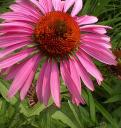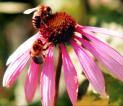
When a person enters the final stage of life on earth, two different dynamics are at work which are closely interrelated and interdependent. On the physical plane, the body begins the final process of shutting down, which will end when all the physical systems cease to function. Usually this is an orderly and undramatic progressive series of physical changes which are not medical emergencies requiring invasive interventions. These physical changes are a normal, natural way in which the body prepares itself to stop, and the most appropriate kinds of responses are comfort enhancing measures.
The other dynamic of the dying process at work is on the emotional-spiritual-mental plane, and is a different kind of process. The spirit of the dying person begins the final process of release from the body, its immediate environment, and all attachments. This release also tends to follow its own priorities, which may include the resolution of whatever is unfinished of a practical nature and reception of permission to “let go” from family members. These events are the normal, natural way in which the spirit prepares to move from this existence into the next dimension of life. The most appropriate kinds of responses to the emotional-spiritual-mental changes are those which support and encourage this release and transition.
When a person’s body is ready and wanting to stop, but the person is still unresolved or unreconciled over some important issue or with some significant relationship, he or she may tend to linger in order to finish whatever needs finishing even though he or she may be uncomfortable or debilitated. On the other hand, when a person is emotionally-spiritually-mentally resolved and ready for this release, but his or her body has not completed its final physical shut down, the person will continue to live until that shut down process ceases.
The experience we call death occurs when the body completes its natural process of shutting down, and when the spirit completes its natural process of reconciling and finishing. These two processes need to happen in a way appropriate and unique to the values, beliefs, and lifestyle of the dying person.
Therefore, as you seek to prepare yourself as this event approaches, the members of your Hospice care team want you to know what to expect and how to respond in ways that will help your loved one accomplish this transition with support, understanding, and ease. This is the great gift of love you have to offer your loved one as this moment approaches.
The emotional-spiritual-mental and physical signs and symptoms of impending death which follow are offered to help you understand the natural kinds of things which may happen and how you can respond appropriately. Not all these signs and symptoms will occur with every person, nor will they occur in this particular sequence. Each person is unique and needs to do things in his or her own way. This is not the time to try to change your loved one, but the time to give full acceptance, support, and comfort.
The following signs and symptoms described are indicative of how the body prepares itself for the final stage of life.
Coolness
The person's hands and arms, feet and then legs may be increasingly cool to the touch, and at the same time the color of the skin may change. This a normal indication that the circulation of blood is decreasing to the body’s extremities and being reserved for the most vital organs. Keep the person warm with a blanket, but do not use one that is electric.
Sleeping
The person may spend an increasing amount of time sleeping, and appear to be uncommunicative or unresponsive and at times be difficult to arouse. This normal change is due in part to changes in the metabolism of the body. Sit with your loved one, hold his or her hand, but do not shake it or speak loudly. Speak softly and naturally. Plan to spend time with your loved one during those times when he or she seems most alert or awake. Do not talk about the person in the person’s presence. Speak to him or her directly as you normally would, even though there may be no response. Never assume the person cannot hear; hearing is the last of the senses to be lost.
Disorientation
The person may seem to be confused about the time, place, and identity of people surrounding him or her including close and familiar people. This is also due in part to the metabolism changes. Identify yourself by name before you speak rather than to ask the person to guess who you are. Speak softly, clearly, and truthfully when you need to communicate something important for the patient’s comfort, such as, It is time to take your medication, and explain the reason for the communication, such as, so you won’t begin to hurt. Do not use this method to try to manipulate the patient to meet your needs.
Incontinence
The person may lose control of urine and/or bowel matter as the muscles in that area begin to relax. Discuss with your Hospice nurse what can be done to protect the bed and keep your loved one clean and comfortable.
Congestion
The person may have gurgling sounds coming from his or her chest as though marbles were rolling around inside these sounds may become very loud. This normal change is due to the decrease of fluid intake and an inability to cough up normal secretions. Suctioning usually only increases the secretions and causes sharp discomfort. Gently turn the person s head to the side and allow gravity to drain the secretions. You may also gently wipe the mouth with a moist cloth. The sound of the congestion does not indicate the onset of severe or new pain.
Restlessness
The person may make restless and repetitive motions such as pulling at bed linen or clothing. This often happens and is due in part to the decrease in oxygen circulation to the brain and to metabolism changes. Do not interfere with or try to restrain such motions. To have a calming effect, speak in a quiet, natural way, lightly massage the forehead, read to the person, or play some soothing music.
Urine Decrease
The person's urine output normally decreases and may become tea colored referred to as concentrated urine. This is due to the decreased fluid intake as well as decrease in circulation through the kidneys. Consult with your Hospice nurse to determine whether there may be a need to insert or irrigate a catheter.
Fluid and Food Decrease
The person may have a decrease in appetite and thirst, wanting little or no food or fluid. The body will naturally begin to conserve energy which is expended on these tasks. Do not try to force food or drink into the person, or try to use guilt to manipulate them into eating or drinking something. To do this only makes the person much more uncomfortable. Small chips of ice, frozen Gatorade or juice may be refreshing in the mouth. If the person is able to swallow, fluids may be given in small amounts by syringe (ask the Hospice nurse for guidance). Glycerin swabs may help keep the mouth and lips moist and comfortable. A cool, moist washcloth on the forehead may also increase physical comfort.

Breathing Pattern Change
The person s regular breathing pattern may change with the onset of a different breathing pace. A particular pattern consists of breathing irregularly, i.e., shallow breaths with periods of no breathing of five to thirty seconds and up to a full minute. This is called Cheyne-Stokes breathing. The person may also experience periods of rapid shallow pant-like breathing. These patterns are very common and indicate decrease in circulation in the internal organs. Elevating the head, and/or turning the person onto his or her side may bring comfort. Hold your loved one’s hand. Speak gently.
Normal Emotional, Spiritual, and Mental Signs and Symptoms with Appropriate Responses
Withdrawal
The person may seem unresponsive, withdrawn, or in a comatose-like state. This indicates preparation for release, a detaching from surroundings and relationships, and a beginning of letting go. Since hearing remains all the way to the end, speak to your loved one in your normal tone of voice, identifying yourself by name when you speak, hold his or her hand, and say whatever you need to say that will help the person let go.
Vision-like experiences
The person may speak or claim to have spoken to persons who have already died, or to see or have seen places not presently accessible or visible to you. This does not indicate an hallucination or a drug reaction. The person is beginning to detach from this life and is being prepared for the transition so it will not be frightening. Do not contradict, explain away, belittle or argue about what the person claims to have seen or heard. Just because you cannot see or hear it does not mean it is not real to your loved one. Affirm his or her experience. They are normal and common. If they frighten your loved one, explain that they are normal occurrences.
Restlessness
The person may perform repetitive and restless tasks. This may in part indicate that something still unresolved or unfinished is disturbing him or her, and prevents him or her from letting go. Your Hospice team members will assist you in identifying what may be happening, and help you find ways to help the person find release from the tension or fear. Other things which may be helpful in calming the person are to recall a favorite place the person enjoyed, a favorite experience, read something comforting, play music, and give assurance that it is OK to let go.
Fluid and Food Decrease
When the person may want little or no fluid or food, this may indicate readiness for the final shut down. Do not try to force food or fluid. You may help your loved one by giving permission to let go whenever he or she is ready. At the same time affirm the person s ongoing value to you and the good you will carry forward into your life that you received from him or her.
Decreased Socialization
The person may only want to be with a very few or even just one person. This is a sign of preparation for release and affirms from whom the support is most needed in order to make the appropriate transition. If you are not part of this inner circle at the end, it does not mean you are not loved or are unimportant. It means you have already fulfilled your task with your loved one, and it is the time for you to say Good-bye. If you are part of the final inner circle of support, the person needs your affirmation, support, and permission.
Unusual communication
The person may make a seemingly out of character or non sequitur statement, gesture, or request. This indicates that he or she is ready to say Good-bye and is testing you to see if you are ready to let him or her go. Accept the moment as a beautiful gift when it is offered. Kiss, hug, hold, cry, and say whatever you most need to say.
Giving Permission
Giving permission to your loved one to let go, without making him or her guilty for leaving or trying to keep him or her with you to meet your own needs, can be difficult. A dying person will normally try to hold on, even though it brings prolonged discomfort, in order to be sure those who are going to be left behind will be all right. Therefore, your ability to release the dying person from this concern and give him or her assurance that it is all right to let go whenever he or she is ready is one of the greatest gifts you have to give your loved one at this time.
Saying Good-bye
When the person is ready to die and you are able to let go, then is the time to say, Good-bye. Saying Good-bye is your final gift of love to your loved one, for it achieves closure and makes the final release possible. It may be helpful to lay in bed and hold the person, or to take his or her hand and then say everything you need to say.
It may be as simple as saying, I love you. It may include recounting favorite memories, places, and activities you shared. It may include saying, I ’m sorry for whatever I contributed to any tension or difficulties in our relationship. It may also include saying, Thank you for...
Tears are a normal and natural part of saying, Good-bye. Tears do not need to be hidden from your loved one or apologized for. Tears express your love and help you to let go.
How Will You Know When Death Has Occurred?
Although you may be prepared for the death process, you may not be prepared for the actual death moment. It may be helpful for you and your family to think about and discuss what you would do if you were the one present at the death moment. The death of a hospice patient is not an emergency. Nothing must be done immediately.
The signs of death include such things as no breathing, no heartbeat, release of bowel and bladder, no response, eyelids slightly open, pupils enlarged, eyes fixed on a certain spot, no blinking, jaw relaxed and mouth slightly open. A hospice nurse will come to assist you if needed or desired. If not, phone support is available.
The body does not have to be moved until you are ready. If the family wants to assist in preparing the body by bathing or dressing, that may be done. Call the funeral home when you are ready to have the body moved, and identify the person as a Hospice patient. The police do not need to be called. The Hospice nurse will notify the physician.
Thank you
We of Hospice thank you for the privilege of assisting you with the care of your loved one. We salute you for all you have done to surround your loved one with understanding care, to provide your loved one with comfort and calm, and to enable your loved one to leave this world with a special sense of peace and love.
You have given your loved one one of the most wonderful, beautiful, and sensitive gifts we humans have to offer, and in giving that gift have given yourself a wonderful gift as well.
Hospice of North Central Florida
Posted by philcutrara1
at 9:31 PM EDT
Updated: Tuesday, 17 May 2005 10:31 PM EDT




 In the Republic of Georgia, formerly part of the Soviet Union, it is not unusual for people to live beyond 100 years of age as active members of society. When Russians marry they propose a toast to the bride and groom gifting them Georgian longevity. What is their secret?
In the Republic of Georgia, formerly part of the Soviet Union, it is not unusual for people to live beyond 100 years of age as active members of society. When Russians marry they propose a toast to the bride and groom gifting them Georgian longevity. What is their secret? 






